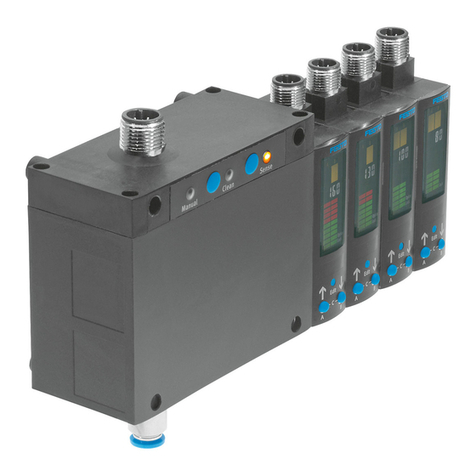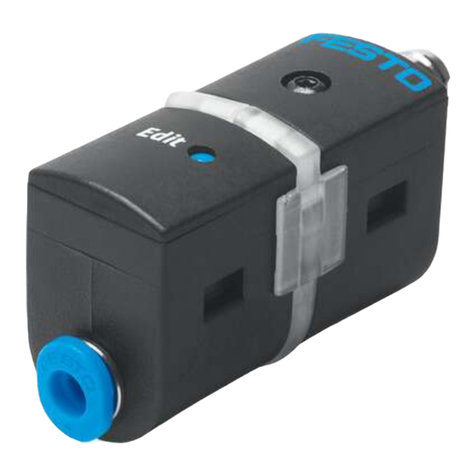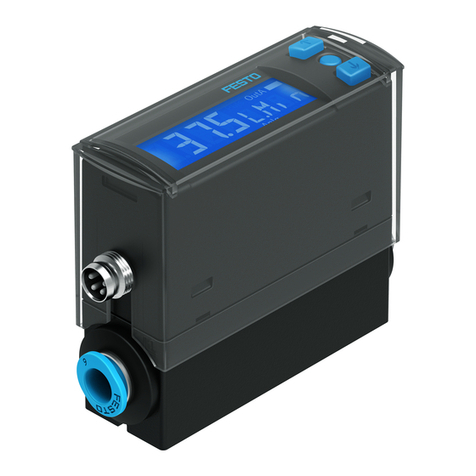Festo SDBT-MSX Parts list manual

Translation of the original instructions
© 2019 all rights reserved to Festo SE & Co. KG
1 Further applicable documents
All available documents for the product èwww.festo.com/pk.
2 Safety
2.1 Intended use
This product is intended for sensing the position of magnets (e.g. the piston posi
tion) in Festo products. The device is intended for use in an industrial environ
ment.
2.1.1 Area of application and approval
In combination with the UL inspection mark on the product, the information in this
section must also be observed in order to comply with the certification conditions
of Underwriters Laboratories Inc. (UL) for USA and Canada.
UL approval information
Product category code NRKH, NRKH7
File number E232949
Considered standards UL 609471, UL 6094752
C22.2 No. 609471, C22.2 No. 6094752
UL mark
Tab. 1
Only use power sources which guarantee reliable electrical isolation of the oper
ating voltage in accordance with IEC/EN 602041. Observe also the general
requirements for PELV power circuits in accordance with IEC/EN 602041. Only for
connection to a NEC/CEC Class 2 supply. The device shall be supplied from an
isolating transformer having a secondary listed fuse rated 1 A.
3 Product overview
3.1 Structure
1Connecting cable
2Open cable end (SDBTMSX...LE)
3Plug connector M8
(SDBTMSX...M8)
4Marking of sensing range
5Green LED: display of sensing
range; only in teachin mode
6Yellow LED: switching status dis
play
7Retaining screw
8Capacitive operating key
Fig. 1
3.2 Function
The proximity sensor SDBTMSX detects the magnetic field of the piston magnet.
In the sensing range of the proximity switch, a switching point can be pro
grammed. To set a switching point in the sensing range of the proximity sensor,
there are two options:
– Auto teachin
– Capacitive operating key
1Sensing range
2Switching window
3Hysteresis
4Teachin point
Fig. 2
4 Installation
4.1 Electrical
WARNING!
Risk of injury due to electric shock.
• For the electrical power supply, use only PELV circuits in accordance with IEC
602041/EN 602041 (Protective ExtraLow Voltage, PELV).
• Observe the general requirements of IEC 602041/EN602041 for PELV cir
cuits.
• Only use voltage sources that ensure a reliable electric separation from the
mains network in accordance with IEC 602041/EN 602041.
Circuit diagrams
SDBT…PU…LE SDBT…PU…M8
SDBT…NU…LE SDBT…NU…M8
Tab. 2
4.2 Mechanical
• Mount the proximity sensor in the end position of the piston so that the end
position is in the sensing range of the sensor. If available, the orientation aid
provides the marking of the piston end position on the drive.
1Marking of the piston end position
on the drive (if available)
2Retaining screw
3Marking of sensing range
4Tslot
Fig. 3
8125856
SDBT-MSX
Proximity Sensor
8125856
201911a
[8125858]
Instructions|Operating
Festo SE & Co. KG
Ruiter Straße 82
73734 Esslingen
Germany
+49 711 3470
www.festo.com

5 Commissioning
5.1 Automatic switching point setting: auto teach-in
Prerequisite: proximity sensor is in delivery status.
1. Mount the proximity sensor roughly in the end positionè 4.2 Mechanical.
2. Connect the proximity sensorè 4.1 Electrical.
ÄProximity sensor is automatically taught in during operation, e.g. upon
initial commissioning of the complete system.
Application notes on auto teach-in
During auto teachin, each >100ms stop of the piston within the sensing range is
output as a switching point. If the piston at this position reverses its direction of
movement and leaves the sensing range without further stops, this switching
point is saved temporarily.
If the piston stops 4x consecutively at the same position, reverses its direction of
movement and leaves the sensing range without further stops, this position is
saved as a final switching point. Auto teachin is complete.
The process described corresponds with the classic use case: proximity sensor
query at the end stop of the piston stroke or at the end stop of the customer
application.
If the piston stroke is smaller than the sensing range of the SDBTMSX, ensure
that the second reversal point of the piston is outside the sensing range during
auto teachin è Tab. 3.
Application notes on auto teach-in
Auto teachin possible:
End position A
Auto teachin possible:
End position B
Auto teachin not possible. The
switching point must be set
using the capacitive operating
key.
Tab. 3
5.2 Manual operation using capacitive operating key
The proximity sensor is parameterised once it is installed.
• Be mindful of the surface temperature of the capacitive operating key and of
the drive.
• Avoid contamination and moisture on the proximity sensor.
5.2.1 Setting the switching point
1. Move the piston into the sensing range of the proximity sensor.
2. Actuate the capacitive operating key 3 times to activate setup mode.
3. Actuate the capacitive operating key once to switch to the menu item "Set
switching point".
4. Actuate the capacitive operating key once.
ÄThe current piston position is taught in as the switching point.
5.2.2 Setting the switching point with variable switching window width
1. Move the piston into the sensing range of the proximity sensor.
2. Actuate the capacitive operating key 3 times to activate setup mode.
3. Actuate the capacitive operating key twice to switch to the menu item "Set
switching point with variable switching window width".
4. Actuate the capacitive operating key once.
ÄThe current piston position is taught in as a switching point with approx.
2mm switching window width.
Every other keystroke increases the switching window width by approx.
1mm. A max. switching window width of 15mm is possible.
5.2.3 PNP/NPN switch-over
1. Actuate the capacitive operating key 3 times to activate setup mode.
2. Actuate the capacitive operating key 3 times to switch to the menu item
"Switch over between PNP / NPN".
3. Actuate the capacitive operating key once to switch between PNP> NPN or
NPN> PNP.
5.2.4 NO/NC switch-over
1. Actuate the capacitive operating key 3 times to activate setup mode.
2. Actuate the capacitive operating key 4 times to switch to the menu item
"Switch over between NO / NC".
3. Actuate the capacitive operating key once to switch between NO> NC or
NC> NO.
5.3 Menu structure
Green LED on & yellow LED off:
piston magnet in sensing range; no switching point
Set-up mode
Flashes yellow and
green in the form of
moving lights
Set switching point
Green ON: teach-in possible1)
Flashes yellow once, then 2 s
pause
Set switching point with variable width
of switching window
Flashes yellow 2 times, then 2 s
pause
Switch: PNP ßà NPN
Flashes yellow 3 times, then 2 s
pause
Current status: Green ON: PNP
green OFF: NPN
Reset to factory settings
Yellow + green flash
simultaneously at 2.5 Hz
3 x Number of actuations invalid
1 x
2 x
3 x
10 x
Switching point set
Width of switching window 2 mm
1 x
N x
1 x
No switching point set
PNP (SDBT-…-PU)
NPN (SDBT-…-NU)
NO
1 x
Termination
Yellow lights up
for 0.5 s
3 s
t > 60 s
Error
Green flashes at
3 Hz for 1 s
N x = press capacitive operating key (e.g.: 3 x);
Max. 1 second pause between two consecutive presses. After a 1 second pause, entry is copied.
= LED ON / LED flashes / LED OFF (e.g.: yellow LED)
1) A switching point can only be set when the green LED is ON.
When the green LED is flashing at 1.5Hz, the magnet is located in the region of the function reserve. It is not possible to set a
switching point. The function reserve is required for the safe setting of switching points in the edge region.
When the green LED is OFF, the magnet is outside the sensing range. It is not possible to set a switching point.
Switch:
PNP àNPN or:
NPN àPNP
3 s = hold the capacitive operating key pressed for at least 3 seconds
Menu: (green LED flashes when the capacitive operating key is pressed)
Both LEDs off:
Outside the sensing range; no switching point
Both LEDs on:
Piston magnet in sensing range; switching point
Green LED off & yellow LED on: cylinder switch operation:
switching point finally programmed as a teach-in value
Green ON: teach-in possible1)
Switching point set & width of switching
window + 1 mm:
N=1: 2 mm
N=2: 3 mm
…
N=14: 15 mm (max. width of switching
window)
Display: PNP / NPN
Flashes yellow 5 times, then 2 s
pause
Current status: Green ON: PNP
green OFF: NPN
5 x 1 x
Exit
Switch: NO ßà NC
Flashes yellow 4 times, then 2 s
pause
Current status: Green ON: NO
Green OFF: NC
4 x
1 x Switch:
NO àNC or:
NC àNO
Display with factory settings [NO]
Fig. 4
6 Reset to factory settings.
Parameter Factory setting
Operating mode Auto teachin
Switching output No switching point programmed
Configuration of the switching output:
– SDBT…PU: PNP
– SDBT…NU: NPN
Switching element function: NO
Variable switching window width Not programmed
Tab. 4
1. Actuate the capacitive operating key 3 times to activate setup mode.
2. Actuate the capacitive operating key 10 times to switch to the menu item
"Reset to factory settings".
3. Actuate the capacitive operating key once.
ÄProximity switch is reset to factory settings.

7 Malfunctions
7.1 Diagnostics via LEDs
Display Meaning Measure
Status indication:
– Piston outside the sensing range
– Piston not at switching point
Normal operating caseBoth LEDs
off
Error:
– Power supply fault
– Connecting cable or sensor defective
– Check power supply
– Check connecting cable
– Replace device
Green LED
flashes at
6 Hz
Hardware error – Disconnect and connect proximity
sensor
– Replace device
Tab. 5
7.2 General malfunctions
Error description Possible cause Measures/remedy
Proximity sensor defective – Replace proximity sensor
Operating voltage not connected
or outside the operating voltage
range
– Comply with operating
voltage range
Short circuit or overload at the
output
– Rectify short circuit/over
load
Magnetic or ferromagnetic objects
close to the proximity sensor
– Keep magnetic or ferromag
netic objects clear of the
proximity sensor
– Conditions during teachin of
the switching point must cor
respond to operating condi
tions (e.g. no screwdriver in
the locking screw)
Incorrect or unexpected
signals at the output
Orientation of the proximity
sensor rotated 180° in the slot
after adjustment of the switching
point
– Reset switching point (with
auto teachin or operating
key)
Proximity sensor defective – Replace proximity sensorSwitching output does not
react in accordance with
the settings Short circuit or overload at the
output
– Rectify short circuit/over
load
Capacitive operating key
does not react to input
Dirt or moisture on the proximity
sensor
– Wipe proximity sensor with a
dry cloth
Tab. 6
8 Technical data
SDBT-MSX
Operating voltage range [VDC] 10 …30
Max. output current [mA] 100
Operating temperature range [°C] –40…+85 (UL: +80)
Ambient temperature with
flexible cable installation
[°C] –20…+85 (UL: +80)
Degree of protection
(EN60529)
IP65 / IP68
Tab. 7
Other Festo Accessories manuals

Festo
Festo SFAM User manual
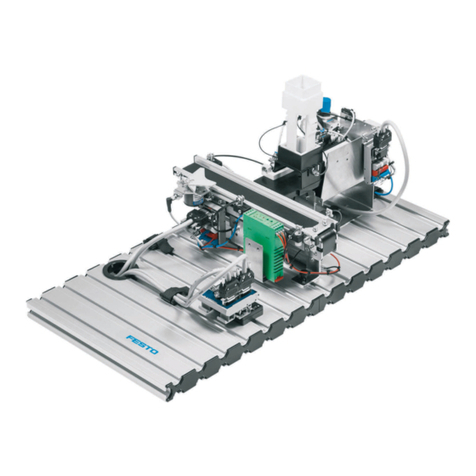
Festo
Festo MPS 8034566 User manual
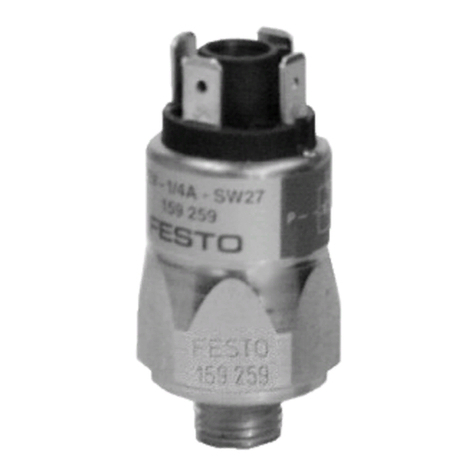
Festo
Festo PEV-1/4A Series User manual

Festo
Festo CP Lab User manual

Festo
Festo SDE5 series User manual

Festo
Festo SFAH Parts list manual

Festo
Festo CP Lab User manual

Festo
Festo NEBU-M12W8-K N-LE8 Series User manual
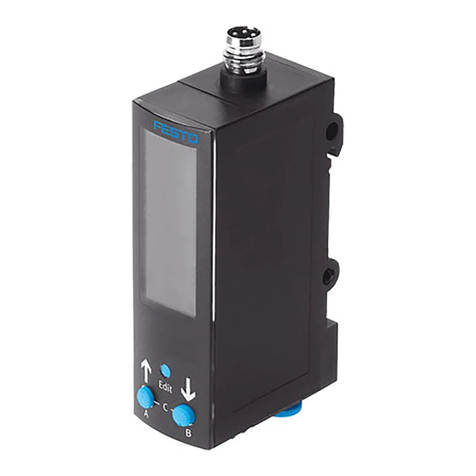
Festo
Festo SDE3 series User manual

Festo
Festo ASLR-D-L1 User manual
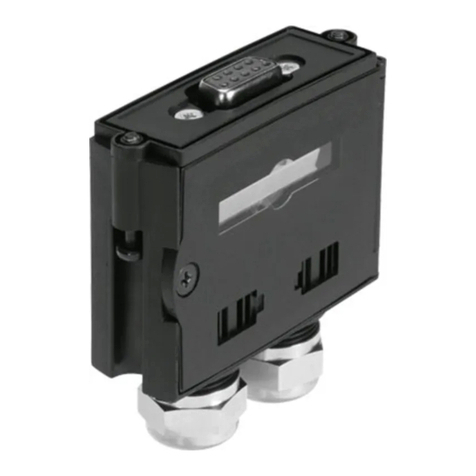
Festo
Festo NECA-S1G9-P9-MP3-SA User manual

Festo
Festo SRBC User manual
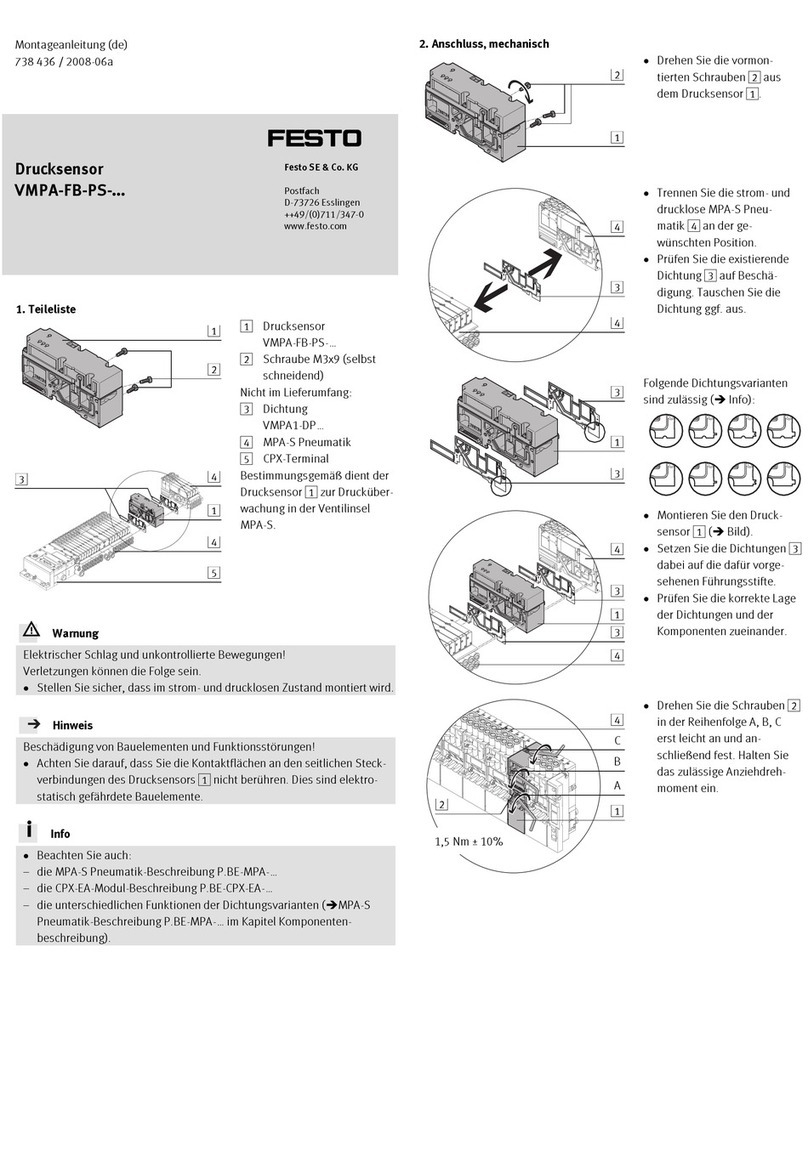
Festo
Festo VMPA-FB-PS Series User manual

Festo
Festo SFAW Series User manual
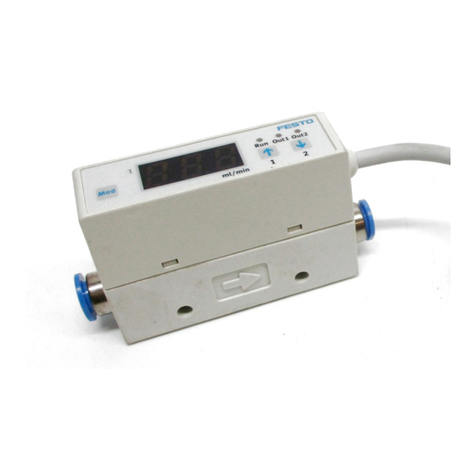
Festo
Festo SFE3 Series User manual
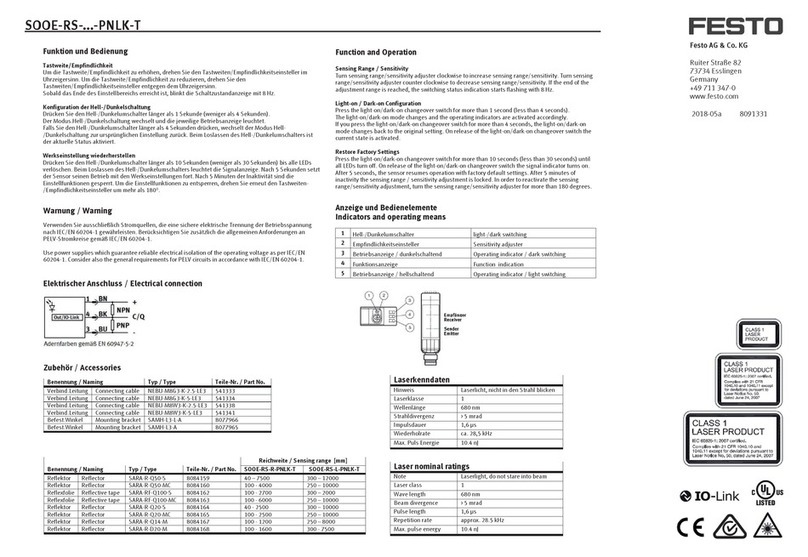
Festo
Festo SOOE-RS PNLK-T Series User manual

Festo
Festo SDE5 series Parts list manual

Festo
Festo SRAP-M-CA1 Series User manual
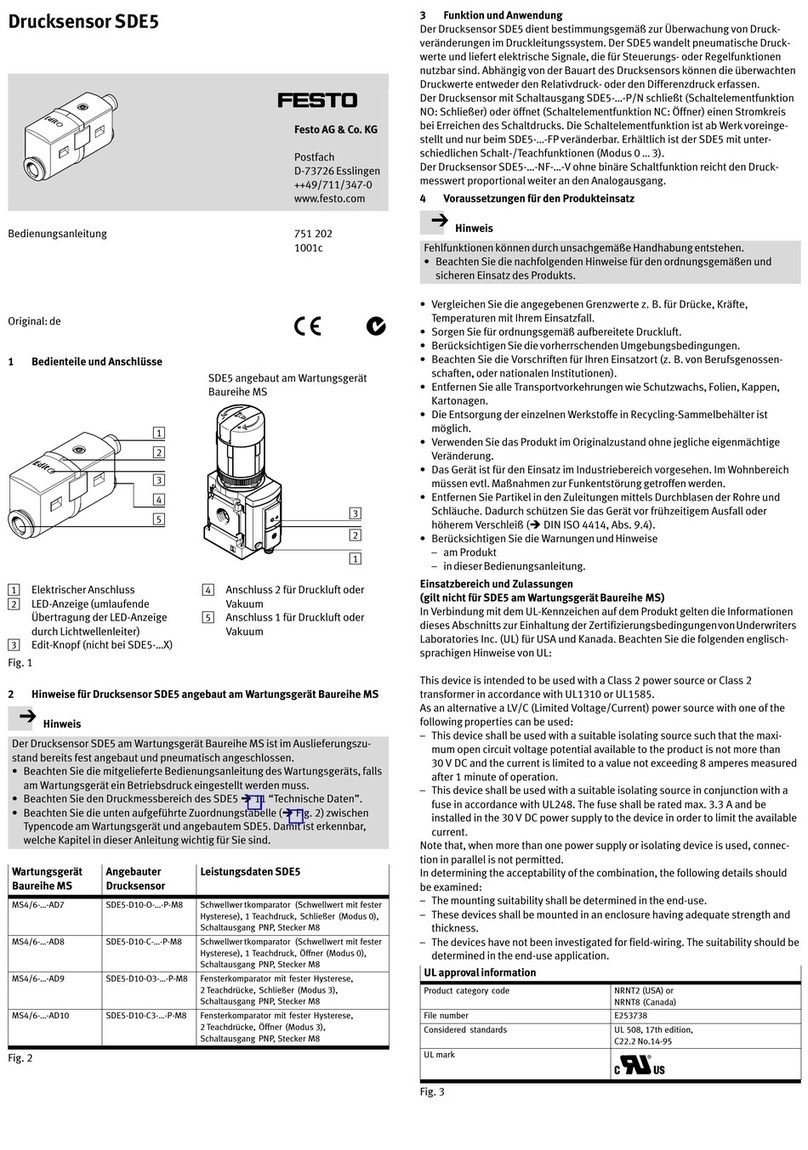
Festo
Festo SDE5 series User manual

Festo
Festo AS-i Series Parts list manual

